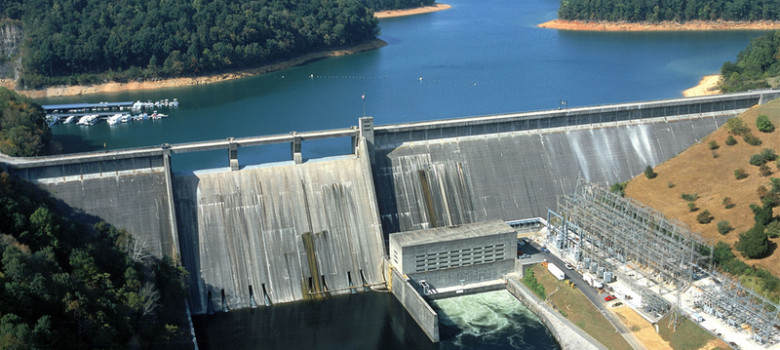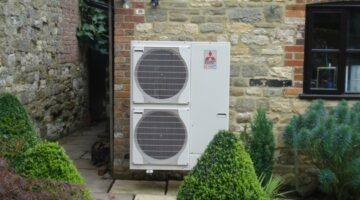
What is Hydroelectric Power?
Hydroelectric power is a very well established form of providing energy. In the last decade, 20% of the world’s electricity came from hydroelectric plants (88% of the renewable energy supply). This balance will change as there are now competing renewable energy generating sources like solar PV, and wind power. Hydroelectric power means harnessing power from moving water using an electric generator. In the UK, total hydroelectric power capacity is just under 2%, which makes up under a fifth of the total renewable energy generation capacity. When people around the world think about hydroelectric power, they probably think of the Hoover Dam, which is located on the Colorado River in the USA, between Arizona and Nevada. It was completed in 1936 and had a maximum generating capacity of 1.3GW.
How does Hydroelectric Power Work?
Power is generated as massive turbines spin, which is caused by water flowing over them. When the turbines spin the magnets in the generator, this causes a conversion of kinetic energy to electrical energy. The amount of power generated varies depending on the volume of water that passes over the turbines and the difference in height between the water source and the water’s outflow (known as the head). There are different bands of hydroelectric power plant, divided by the amount of energy they can produce. The power plant divides are as follows – large (few hundred MWs to 10GW), small (up to 10MW), micro (up to 100KW) and pico (under 5KW).
One of the major advantages of hydroelectric power is that it can be harnessed within seconds depending on demand, and as such is one of the only means of storing large quantities of electrical energy for peak demand. This is achieved by holding large amounts of water in a reservoir behind a dam with a hydroelectric power plant below. For example Dinorwig, in Wales can help provide emergency power to fill the demand gaps from a city such as Liverpool. Most power stations, including fossil fuel and nuclear have to stay on at all times as they take time to warm up to produce the power, and cool down for maintenance. As a result, these are used to service base demand, then hydroelectric power can service any spikes in demand, and then water can be pumped back up into the reservoirs when demand is less (during the night).
Types of Hydroelectric Power
Hydroelectric Power Dam Storage
This is the conventional hydroelectric power station most people refer to when discussing hydroelectric power. It involves building a dam across a river, which traps the water creating a large artificial lake or reservoir behind it. To create electricity, gates are opened at the bottom of the dam and gravity pushes the water through the gates and down a pipe known as penstock, which delivers the water directly to the turbines built into the structure of the dam. This fast flowing water turns the turbines, and the generator system converts this kinetic energy into electrical energy. An example of a hydroelectric power dam, is the Kielder Water reservoir, located in Northumberland, operated by RWE Npower and is the largest system in England.
Hydroelectric Power Pumped Storage
Pumped storage hydroelectric power, as described in the Energy Storage section requires two reservoirs, one at high altitude and one at low altitude. When the water is released from the high altitude reservoir, energy is created by the downflow which is directed through high-pressure shafts, linked to turbines. This pressure drives the turbines which in turn power the generators that create the electricity. When the high altitude reservoir is empty, water is pumped back to it from the lower reservoir. This is linked with a pump shaft to the turbine shaft, using a motor to drive the pump.
In the UK, Dinorwig Hydroelectric Power plant uses pump motors that are powered from electricity from the grid, when the electricity is cheaper overnight, and demand is at its lowest. Hydroelectric power pumped storage generation therefore offers a critical back-up facility during periods of excessive demand, whilst being efficient in storing energy during periods of low demand.
Run-of-the-river Hydroelectricity
Some hydroelectric power systems utilise the natural flow of a river to create electricity without needing to build a dam. These types of hydroelectric power station involve forcing the river flow through penstocks and turbines to create the electricity, but the structures that are put across the river are far smaller than used in the hydroelectric power dam storage described above.
In Beeston, Nottinghamshire, the hydroelectric power plant run by United Utilities is the largest run-of-the-river system in England. The difference between a dam and a run-of-the-river system is that the latter uses free flowing water, and has minimal storage capacity, which has its advantages and disadvantages. The system requires volume of water passing through and without storage capacity may lack the power of velocity. The dam and the river systems can both be example of diversion schemes, where they can both use water that is channelled from a river or a lake
Hydroelectric Power Industry Development
In the UK, the largest hydroelectric power station is at Dinorwig, which is capable of generating 1.8GW of power in just 12 seconds. However looking around the world, this is dwarfed by the largest hydroelectric power station, the Three Gorges Dam located in China. This hydroelectric power plant has a generating capacity of 20.3GW, which at the time was expected to service 10% of China’s electricity needs, however since their demand has increased so dramatically in recent times, it currently only services about 3%.
Hydroelectric power generators in the UK are eligible for Renewable Obligation Certificates (ROCs) with stations commissioned after 2002 that have 20MW of power output and for all that are below this level. According to the DECC, there is no national strategy for nationwide development of hydroelectric power, but the government is committed to do everything in its power to support developers, community initiatives and small scale developers being able to invest and build hydro projects. In addition, schemes up to 50kW can only apply for FITs, whereas schemes between 50kW and 5MW can choose between FITs or ROCs.












Would like someone to quote for building HEP system on our farm in north Bucks.
Hi Emily Railson!
Did you already found something. Im also looking for someone who can make this in our farms in Europe.
Please let me know!
I love this website but, There is barely any examples for my project.
Same
Yeah same
yeah same
same here #feel your pain
Hi, after the conversion of kinetic energy to electrical energy, how is it then transferred to homes?
same the power whosacka we quenao puena
Add how much on average the large small micro and pico sizes would cost to produce